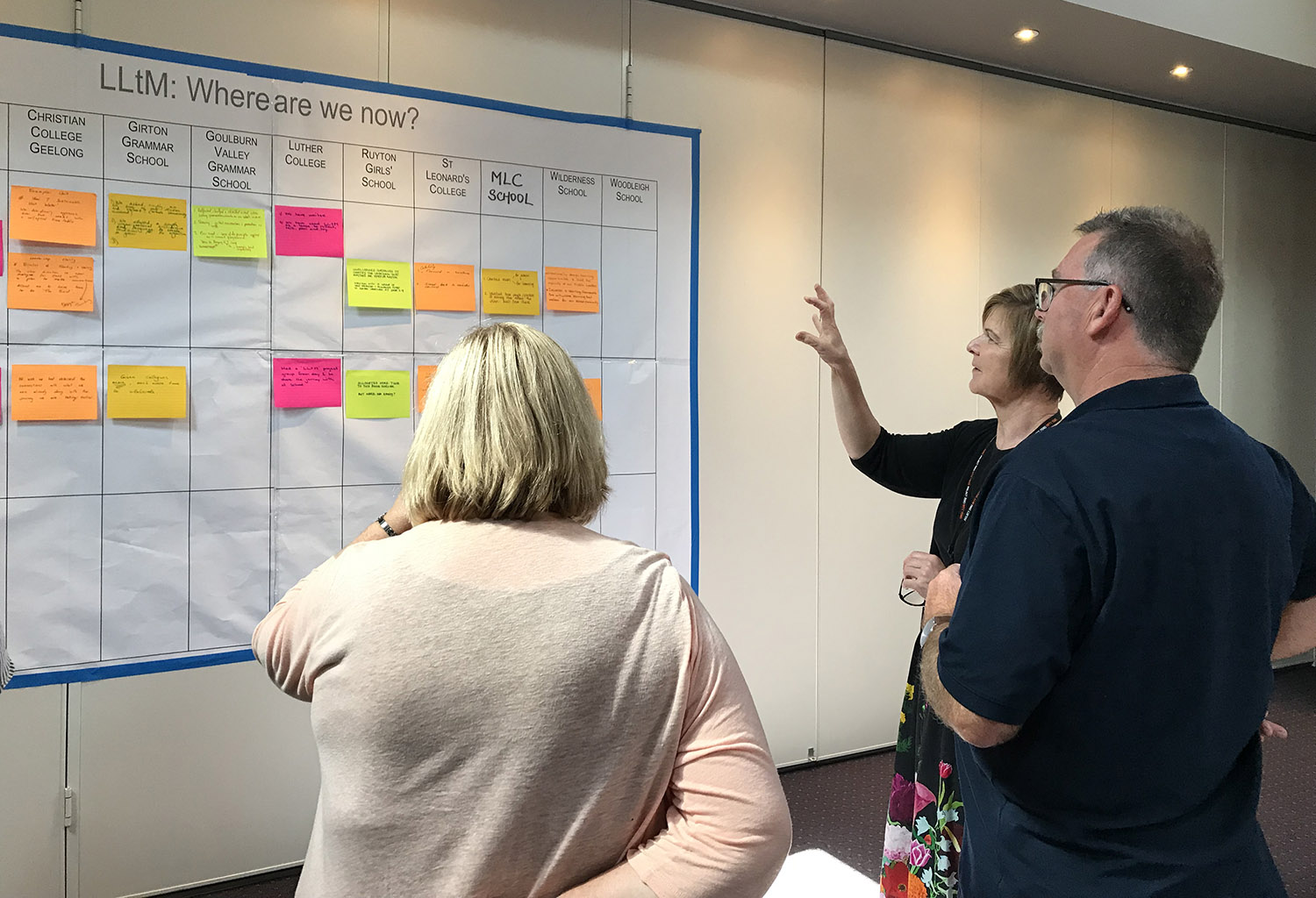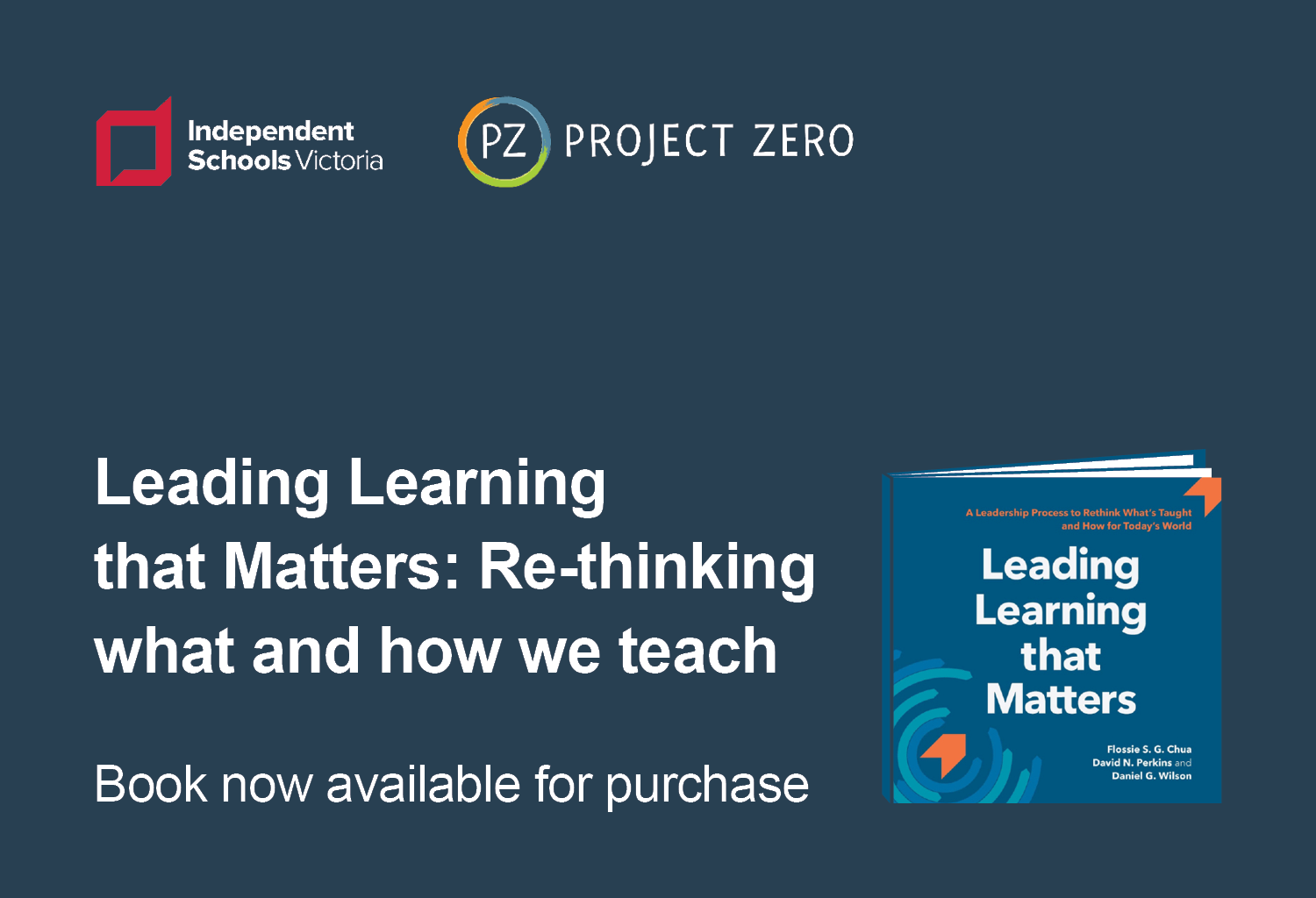Leadership that matters for contemporary learning

7 min read
A collaborative partnership between Independent Schools Victoria and Project Zero at the Harvard Graduate School of Education is giving school Principals vital space to learn, reflect and focus on the learning that matters.
Six large charts dominate the glass panels in the teachers’ room at the Good Shepherd Lutheran Primary School. On each chart is a title written in bold red: Social Learning, Academic Learning, Spiritual Learning, Creative Learning, Technological Learning and Global Learning.
Arranged below each title are yellow Post-it notes on which are written phrases such as lifelong learning, problem solvers, sense of justice/fair play, tech-able, mindfulness/spiritual awareness, leads to action, celebrate difference, numeracy, literacy. Some phrases appear on more than one chart.
Over the weeks, as teachers use the room for lunch and meetings, they revisit the charts. They move Post-its from one chart to another, or consolidate some with others. New Post-its are also added while some existing ones are removed. Over time teachers begin to post questions on the chart papers.
On the Social Learning chart, a teacher writes: Is there a better name for this? An asterisk is added to a question on the Academic Learning chart: Are we referring to the traditional disciplines here? What new disciplines should we include? Another question on the Creative Learning chart poses a puzzle: Is creativity an important part of all rich learning? On the Global Learning chart, a teacher wonders: How do we want our students to engage with our world?
“This marked many conversations among teachers and the leadership team to explore and articulate their collective vision of the learning that matters for their students.”
How can we best prepare students for the contemporary world?
The process leading up to these charts began with school Principal Greg Schneider convening a meeting to involve all teachers in thinking about how they might best prepare their students for the contemporary world.
First, Greg invited teachers to reflect individually on what they thought mattered most for their students to learn: If you could give a little bit of a learning experience, a learning opportunity, or a learning culture, a name or a title, what would you call it?
Next, the teachers got into small groups to share and discuss the kinds of learning that were important to them, documenting key points on Post-its. The staff then came together to read the Post-its before organising them using broad categories that seemed to make sense.
That marked the first of many formal and informal conversations among teachers and the leadership team to explore and articulate their collective vision of the learning that matters for their students.
The charts have since continued to evolve. As the teachers met or took breaks in the teachers’ room, many found their way back to the charts. They re-read notes, re-organised them or added new ones, revised the questions, or wrote fresh ones.
During staff meetings, time was allocated to discussing what mattered for their learners. Over time, a collective vision of the learning that mattered for learners at the Good Shepherd Lutheran Primary School began to take shape.

Four key practices for leading learning that matters
Leading Learning that Matters (LLtM) is a research collaboration between Project Zero at the Harvard Graduate School of Education and Independent Schools Victoria to support highly experienced Principals to meet the challenges and opportunities of modern learning through a two-year research project.
LLtM offers a flexibly structured process that invites participating school leaders and their communities to engage in a reflective process of rethinking some aspects of what’s taught and how it’s taught.
Schools that embark on the LLtM journey engage in steps like those seen at the Good Shepherd Lutheran Primary School. Leaders orchestrate open conversations with teachers over time about what learning that matters looks like in their setting. Discussions examine existing and experimental curricular choices and lead to a clearer picture of what staff feel matters most for their students to learn.
By focusing on what learning matters, Greg and his staff opened possibilities beyond more typical conversations about methods of teaching (how is it learned?) and evaluation (how do we know that learning has happened?).
“While questions about instruction and evaluation are important to schooling, they too often lead to technical approaches to the problems of education, without addressing the fundamental challenge of being relevant to learners and their communities in a swiftly changing world.”
Adaptive leadership and a shared vision
As a leader for learning that matters, Greg’s decisions and actions revealed adaptive leadership behaviours at work. He invited teachers to articulate a shared vision of the learning they felt mattered most for their students. They challenged the status quo in their classrooms using questions such as ‘What is the learning that comes from it? If that’s the learning that’s coming from it, and that’s the value of it, is there a way we can do it where the learning is maximised, and the learning is richer?’
Greg also put the charts in the teachers’ room rather than his room, signalling to teachers that he was not the expert in defining key types of learning. Rather, it was their collective expertise that would get the job done. Making the charts visible in the teachers’ space enabled progress in framing the learning that matters.
Greg also purposefully designed collaborative structures for teachers to work together to transform what and how they teach in the classroom. Instead of operating in silos and working independently towards an externally determined goal (e.g. raising test scores by 8 per cent), teachers worked together to consider what they think and do in their lessons and how it connects to and informs the larger goal of learning. These collaborative structures created interdependencies among teachers: they supported teachers to think together, share ideas, experiment with peer support and get rich feedback.
The language of 'learning that matters'
By including teachers in discussions about what learning matters, Greg pivoted away from traditional professional development that focused on learning specific skills or defined content to support teachers’ individual development. He invited teachers to reflect on what they did well and what values they brought to their work with students. In the process, teachers found a supportive context for intellectual stimulation as they shared ideas, practices and examples.
Teacher Sonia Miniken described it as having the mental space to ask, “why am I teaching this? What is my goal? Why is this important? Can I teach this another way, or using a new strategy or way of thinking? Am I catering for all needs through diversity and modification?” By tapping into their motivation and beliefs – and developing their agency to experiment and take risks with one another – Greg built the capacity in his teachers to grow individually and collectively.
Today, formal and informal conversations on the learning that matters at the Good Shepherd Lutheran Primary School have become de rigueur among teachers. The language of ‘learning that matters’ has been embedded into the everyday processes of the school, as well as the vocabulary used by leaders and teachers to share information and ideas with students, parents and the wider community.
For Greg, sustained progress toward the learning that matters is evident “when people speak and believe in the same language about what matters for their students to learn, and when as a school, we work to make that vision a daily reality in our classrooms.”

Leading Learning that Matters for Principals
LLtM Principals who have embarked on investigating the learning that matters within their school communities have deeply valued the opportunity to come together with other principals on a similar journey and share best practices and challenges with each other. Independent Schools Victoria’s LLtM program is about protecting that vital space and time for Principals to learn, reflect and look at their work through different lenses.
Over two years, LLtM Principals work together with the team at Project Zero-Harvard to plan, test and implement school innovations that prepare their learners to thrive in the complex world in which they’ll live, work and play.
As with all leaders, the role of a Principal has many competing priorities. The LLtM program supports them to keep learning high on the school agenda. As a result, we have seen important ideas and projects come to life and momentum sustained well after the program. Notably, school teams have also been able to build capacity to scale up transformational change. This has been achieved with the time to pause together, look more closely at what matters within their school gates and beyond.
The Leading Learning that Matters book is now available for purchase via the link below. Written by ISV partners Flossie S. G. Chua, David N. Perkins and Daniel G. Wilson – and featuring case studies from Victorian Independent schools – it is a must read for any school leader who wants to ensure their school is preparing students to thrive in the contemporary world.
This article was co-written by Dr Flossie Chua (Principal Investigator, Harvard Graduate School of Education) and Aynur Simsirel (Principal Consultant, ISV).



